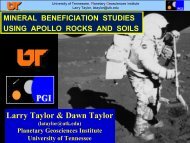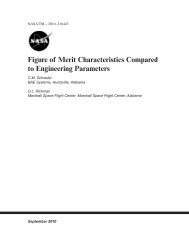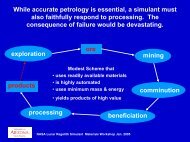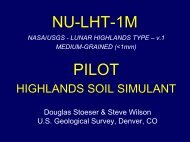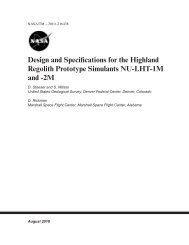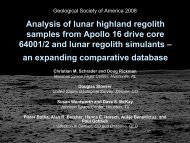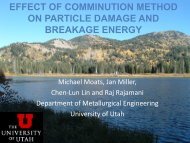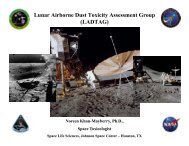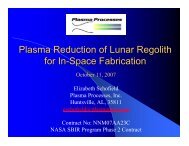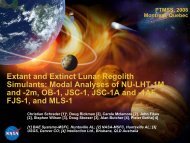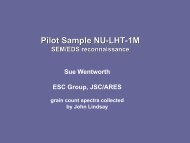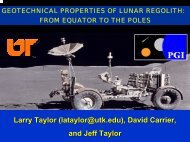Book of Abstracts- Lunar Regolith Simulant Materials Workshop
Book of Abstracts- Lunar Regolith Simulant Materials Workshop
Book of Abstracts- Lunar Regolith Simulant Materials Workshop
You also want an ePaper? Increase the reach of your titles
YUMPU automatically turns print PDFs into web optimized ePapers that Google loves.
SINTERING, MELTING AND CRYSTALLIZATION OF LUNAR SOIL WITH AN EXPERIMENTAL<br />
PETROLOGIC POINT OF VIEW. G. E. L<strong>of</strong>gren, Code KT, NASA-JSC, Houston, TX 77058,<br />
gary.e.l<strong>of</strong>gren@nasa.gov.<br />
Introduction: <strong>Lunar</strong> soils have many unique<br />
properties that affect their sintering, melting, and<br />
crystallization behavior. Previous experimental<br />
studies <strong>of</strong> lunar soil and basalt material can provide<br />
insight into these behaviors for future utilization as<br />
an engineering material.<br />
Procedures: The procedures for sintering,<br />
melting and crystallization and the desired end<br />
products from each <strong>of</strong> these processes are different.<br />
Sintering. Sintering requires temperatures<br />
between the glass transition and solidus temperatures<br />
for glass agglutinate rich soils (glass spherules can<br />
contribute, but not as much). The final products can<br />
have only a limited variation in physical properties<br />
with porosity being one <strong>of</strong> the important ones. The<br />
variations result from variations in the time and<br />
temperature <strong>of</strong> sintering, but also the grain size,<br />
composition, and physical state <strong>of</strong> the soil.<br />
Melting. Melting is a simple process that requires<br />
temperatures between the solidus and liquidus and<br />
superliquidus temperatures, if total melting is<br />
required. A totally melted lunar soil would have<br />
limited uses and would not be a desirable product.<br />
Crystallization. Crystallization is the important<br />
step to producing a custom product. It is a complex<br />
and variable process that can produce a wide variety<br />
<strong>of</strong> products with different physical properties.<br />
Tailoring the physical properties <strong>of</strong> the crystallized<br />
product to desired uses requires extensive<br />
experimentation. Such characteristics as tensile<br />
strength, surface toughness, resistance to fracturing<br />
and insulation properties could all be controlled.<br />
Unfortunately, they cannot all be optimized<br />
simultaneously.<br />
A dynamic crystallization study completed on<br />
lunar soil 15301 [1] demonstrates some <strong>of</strong> the<br />
variations in crystallization properties that can be<br />
obtained. The lunar soil was melted for 10 minutes<br />
to 96 hours at temperatures in the range <strong>of</strong> 1230-<br />
1280°C and either quenched or cooled slowly at<br />
approximately 2°C/hr. Melting at 1280°C produced a<br />
glass while melting at 1230°C produced a partially<br />
crystalline melt with numerous small crystals.<br />
Melting at 1230°C for the different times<br />
produced different degrees <strong>of</strong> melting and<br />
distributions <strong>of</strong> crystals. Resulting textures varied<br />
from poikilitic to fine intersertal to more coarsely<br />
intersertal to even coarser intergranular to subophitic<br />
texture with increasing melting time. The array <strong>of</strong><br />
texture will result in different physical properties for<br />
the final products. Two obvious properties that will<br />
vary are porosity and strength or toughness. This<br />
study was not designed to determine the variation in<br />
physical properties and none were measured. This<br />
study does show what is required to vary the textural<br />
properties <strong>of</strong> the final product and how one would<br />
systematically vary those properties.<br />
Requirements: The best soils to sinter or<br />
crystallize would be ones with the lowest solidus<br />
temperatures and a relatively low liquidus<br />
temperature. Soils with high glass content, either<br />
agglutinates or spheres, will be the most easily<br />
sintered. Glass content is not as important for<br />
melting and crystallization processes, except possibly<br />
with regard for the total energy input for large<br />
quantities. The more glass, the less energy needed to<br />
totally melt a soil from a kinetic point <strong>of</strong> view.<br />
The energy to produce melting is significant and<br />
probably would have to be supplied locally, such as<br />
with a solar furnace with the direct use <strong>of</strong> focused<br />
sunlight, or by solar collectors and stored power.<br />
Important <strong>Simulant</strong> components: What would<br />
be the important simulant properties for experimental<br />
studies Bulk composition controls the liquidus and<br />
solidus temperatures. Both are important for energy<br />
input considerations (latent heat <strong>of</strong> fusion). It would<br />
be desirable to simulate the lower melting soils or<br />
soils at a projected landing site as accurately as<br />
possible.<br />
Bulk composition also dictates the minerals that<br />
are stable, their ratios, what crystallization textures<br />
are possible, and ultimately the physical properties <strong>of</strong><br />
the material. It would be more difficult to simulate<br />
the array <strong>of</strong> minerals and glassy particles. Naturally<br />
high FeO and TiO2 basalt like some found in<br />
Columbia Plateau basalts would be a good base<br />
material. Hawaiian glassy ejecta could be used to<br />
simulate agglutinates and spherules.<br />
The unique grain size distribution <strong>of</strong> lunar soils<br />
would also be important for determining their melting<br />
properties as the fine-grained component melts most<br />
readily. This property is particularly important for<br />
sintering applications.<br />
Thus, experimental studies would require a very<br />
faithful simulant, but would not require large<br />
quantities. For some experimental studies that can be<br />
done with a few grams, actual lunar soil could be<br />
used. If extensive physical testing <strong>of</strong> the final<br />
products is required, simulants would be necessary.<br />
An additional source <strong>of</strong> information: Basalt<br />
has a long history <strong>of</strong> use as the raw material for<br />
casting ceramic products for a wide variety <strong>of</strong> uses<br />
25



